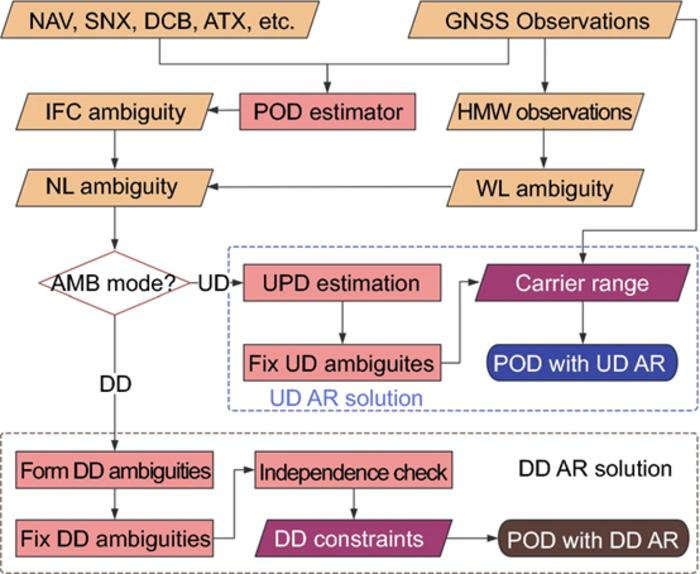Recently, a study introduced a novel method that significantly enhances the precision and efficiency of precise orbit determination and clock estimation the Global Positioning System (GPS), BeiDou, Galileo, and Global’naya Navigatsionnaya Sputnikovaya Sistema (GLONASS) satellite systems. This work in Un-Differenced (UD) Integer Ambiguity Resolution (IAR) simplifies satellite navigation data processing and dramatically improves precise positioning accuracy.
In the evolving Global Navigation Satellite Systems (GNSS) landscape, China’s International GNSS Monitoring and Assessment System (iGMAS) stands out for its global monitoring and evaluation of GNSS constellations. Crucial to enhancing GNSS data accuracy and reliability is resolving integer ambiguities in phase observations. Traditionally managed at the Double Differenced (DD) level to remove hardware delays, recent innovations now allow Integer Ambiguity Resolution (IAR) at the Un-Differenced (UD) level, eliminating the need for baselines and streamlining the process.
Researchers from iGMAS and its Innovation Application Center (IAC) at Wuhan University have developed and validated an UD IAR approach for integrating quad-systems, including the Global Positioning System (GPS), BeiDou, Galileo, and Global’naya Navigatsionnaya Sputnikovaya Sistema (GLONASS). Published (DOI: 10.1186/s43020-024-00128-7) in the Satellite Navigation journal on April 8, 2024, their research demonstrates significant enhancements in GNSS precise data processing.
The groundbreaking UD IAR technique, by directly calibrating ambiguities from raw carrier phase data into “carrier range” data, bypasses the complex calculations required by the traditional DD method. This innovation not only simplifies the ambiguity resolution process but also increases the resolved integer ambiguities by up to 9%. With a 70% reduction in computational workload, this approach provides a way in the data processing of extensive GNSS networks, with widespread implications from improving autonomous vehicle and aircraft navigation systems to enhancing global environmental monitoring.
Professor Xingxing Li, a leading satellite navigation expert from Wuhan University, highlighted the transformative potential of the UD IAR method, stating, “This work not only improves the accuracy of GNSS precise orbit determination and clock estimation but also simplifies global satellite navigation data processing. It represents an advancement in our ability to provide more reliable and precise GNSS products globally.”
This study represents a significant leap toward achieving more reliable, precise, and efficient satellite navigation capabilities, promising to promote the application of this technology across various areas.

Credit: Satellite Navigation
Recently, a study introduced a novel method that significantly enhances the precision and efficiency of precise orbit determination and clock estimation the Global Positioning System (GPS), BeiDou, Galileo, and Global’naya Navigatsionnaya Sputnikovaya Sistema (GLONASS) satellite systems. This work in Un-Differenced (UD) Integer Ambiguity Resolution (IAR) simplifies satellite navigation data processing and dramatically improves precise positioning accuracy.
In the evolving Global Navigation Satellite Systems (GNSS) landscape, China’s International GNSS Monitoring and Assessment System (iGMAS) stands out for its global monitoring and evaluation of GNSS constellations. Crucial to enhancing GNSS data accuracy and reliability is resolving integer ambiguities in phase observations. Traditionally managed at the Double Differenced (DD) level to remove hardware delays, recent innovations now allow Integer Ambiguity Resolution (IAR) at the Un-Differenced (UD) level, eliminating the need for baselines and streamlining the process.
Researchers from iGMAS and its Innovation Application Center (IAC) at Wuhan University have developed and validated an UD IAR approach for integrating quad-systems, including the Global Positioning System (GPS), BeiDou, Galileo, and Global’naya Navigatsionnaya Sputnikovaya Sistema (GLONASS). Published (DOI: 10.1186/s43020-024-00128-7) in the Satellite Navigation journal on April 8, 2024, their research demonstrates significant enhancements in GNSS precise data processing.
The groundbreaking UD IAR technique, by directly calibrating ambiguities from raw carrier phase data into “carrier range” data, bypasses the complex calculations required by the traditional DD method. This innovation not only simplifies the ambiguity resolution process but also increases the resolved integer ambiguities by up to 9%. With a 70% reduction in computational workload, this approach provides a way in the data processing of extensive GNSS networks, with widespread implications from improving autonomous vehicle and aircraft navigation systems to enhancing global environmental monitoring.
Professor Xingxing Li, a leading satellite navigation expert from Wuhan University, highlighted the transformative potential of the UD IAR method, stating, “This work not only improves the accuracy of GNSS precise orbit determination and clock estimation but also simplifies global satellite navigation data processing. It represents an advancement in our ability to provide more reliable and precise GNSS products globally.”
This study represents a significant leap toward achieving more reliable, precise, and efficient satellite navigation capabilities, promising to promote the application of this technology across various areas.
###
References
DOI
Original Source URL
Funding information
This study is financially supported by the National Natural Science Foundation of China (No. 42204017, No. 41974027, No. 42304019), the special fund of Hubei Luojia Laboratory (220100006), the Sino-German mobility program (Grant No. M-0054), China Postdoctoral Science Foundation (2023M732687), and the Fundamental Research Funds for the Central Universities (2042022kf1001).
About Satellite Navigation
Satellite Navigation (E-ISSN: 2662-1363; ISSN: 2662-9291) is the official journal of Aerospace Information Research Institute, Chinese Academy of Sciences. The aims is to report innovative ideas, new results or progress on the theoretical techniques and applications of satellite navigation. The journal welcomes original articles, reviews and commentaries.
Journal
Satellite Navigation
Subject of Research
Not applicable
Article Title
Orbit and clock products for quad-system satellites with undifferenced ambiguity fixing approach
Article Publication Date
8-Apr-2024
COI Statement
The authors declare that they have no competing interests.



